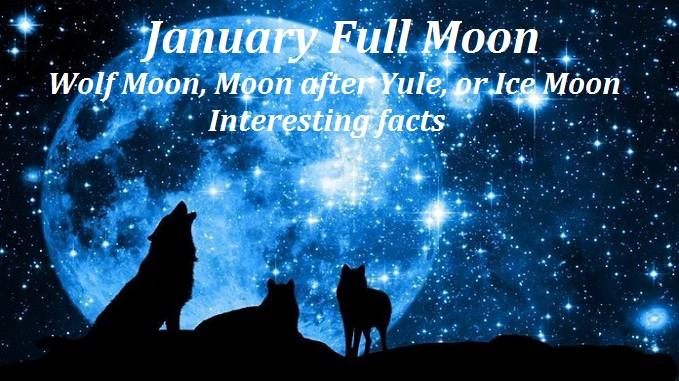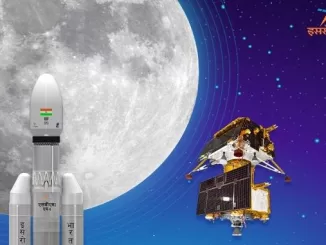
Why is January Full Moon called Wolf Moon, Moon after Yule, or Ice Moon – Interesting facts
♦ Time and Date of “January Full Moon”
The next full Moon will occur on Friday, January 6, 2023, at 6:08 PM EST or 11:08 PM UTC (23:08 GMT), but the moon still appears full the night before and after its peak to the casual stargazer. As always, in honor of the full Moon, the wearing of suitable celebratory celestial costumes is encouraged.
♦ January Full Moon – Wolf Moon
The Full Wolf Moon, which occurs in January and is the year’s first Full Moon, is named after the wolves that are active in the early months of the year. At this time of year, the howling of wolves was often heard.
It got its name from howling wolves. The name is believed to have originated in Celtic and Old English and was carried to North America by European settlers. It is probable that European settlers used the term “Wolf Moon” before arriving in North America.
American Indian Moon names for each month of the year were first published in the Maine Farmer’s Almanac in the 1930s. According to this almanac, the Algonquin tribes named the full Moon in January, or the first full Moon of winter the Wolf Moon, from the packs of wolves that howled outside the villages amid the cold and deep snows of winter.
Whatever the origin of the name Wolf Moon, wolves howl to communicate over long distances in both North America and Europe. It is a way of signaling to the rest of the pack, “Here I am,” or to outsiders, “Stay away.”
According to many sources, it was traditionally believed that wolves howled due to hunger. However, wolves use howls to mark territory, find pack members, strengthen social bonds, and gather for hunting.
While a single wolf’s howl typically lasts 3 to 7 seconds, a chorus by a pack can last 30 to 120 seconds or longer during the breeding season in January – February.
So wolves are especially loud and vocal throughout the first few months of the year, which is perhaps why the month of January has been associated with howling wolves.
Do Wolves Howl at the Moon?
The scientific community has no indication that the Moon phase affects the wolf’s howls in any specific way, although because wolves are nocturnal animals, they are generally more active at night.
Wolves howl toward the direction of the Moon by pointing their faces toward the sky for better acoustics, since projecting their howl upward spreads the sound further.
♦ January Full Moon – Moon After Yule
In Anglo-Saxon culture, the full moon of January was also known as the “Moon After Yule”. That is, Europeans called this the “Moon After Yule”. In pre-Christian Europe, Yule was a three-day winter solstice festival that was usually observed around December 21.
In the 10th Century, King Haakon I associated Yule with Christmas as part of the Christianization of Norway, and this association has spread throughout the countries that follow European traditions.
♦ January Full Moon – Ice Moon
Another name for the January Moon is the Ice Moon, which emphasises the harsh and freezing cold of the season.
♦ Alternative names of January Full Moon
Other traditional names for the January Full Moon include –
- Canada Goose Moon
- Great Moon
- Greetings Moon
- Spirit Moon
- Center Moon
- Cold Moon
- Freeze Up Moon
- Frost Exploding Moon
- Hard Moon
- Severe Moon.
Severe Moon or Center Moon – In some Native American cultures, it is called Severe Moon or Center Moon. The Assiniboine people gave this period the name “Center Moon” since it is in the middle of the winter season.
Stay Home Moon and Quiet Moon – These are other Celtic names for January’s Full Moon.
Cold Moon and Freeze Up Moon – The Algonquian name Freeze Up Moon, as well as the Cree name of Cold Moon, all refer to the freezing chilly temperatures of this season of the year.
Severe Moon and Hard Moon – Severe Moon and Hard Moon, which are Dakota names, refers to the season’s extreme cold and difficult times as well as the fact that the snow can occasionally form a hard crust.
Frost Exploding Moon or Opawahcikanasis – January’s Full Moon is also known as the Frost Exploding Moon or Opawahcikanasis, because during this time of year, one may hear the cracks in some trees as ice builds and then falls off.
January’s Full Moon is also known as the Canada Goose Moon (Tlingit), Great Moon (Cree), Greetings Moon (Western Abenaki), and Spirit Moon (Ojibwe).
Read Also:
Why is August Full Moon called the Sturgeon Moon?
Why is the September Full Moon called the Harvest Moon?
Why is October Full Moon Called Hunter’s Moon?
Why is November Full Moon Called Beaver Moon?
Why is December Full Moon called the Cold Moon?
Copyrighted Material © 2019 - 2024 Prinsli.com - All rights reserved
All content on this website is copyrighted. It is prohibited to copy, publish or distribute the content and images of this website through any website, book, newspaper, software, videos, YouTube Channel or any other medium without written permission. You are not authorized to alter, obscure or remove any proprietary information, copyright or logo from this Website in any way. If any of these rules are violated, it will be strongly protested and legal action will be taken.





Be the first to comment